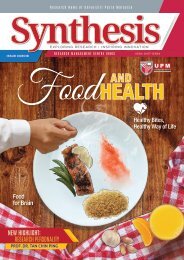SYNTHESIS ISSUE 1 2019: ANIMAL & US
The magazine can be download on our department website at https://rmc.upm.edu.my/majalah_synthesis-3243
The magazine can be download on our department website at https://rmc.upm.edu.my/majalah_synthesis-3243
Create successful ePaper yourself
Turn your PDF publications into a flip-book with our unique Google optimized e-Paper software.
Science & Technology<br />
Figure 1: Transmission cycle of Japanese encephalitis virus between amplifiers (pigs and wild<br />
birds) and mosquito vectors (especially Culex tritaeniorhynchus), including the infection of deadend<br />
hosts (humans, horses, cattle). Source: World Organisation for Animal Health (OIE, www.oie.int)<br />
to the location of farms not within paddy field. The chances<br />
of JEV transmission through Culex spp. to pigs is less due to<br />
the absence of water bodies areas where. Culex spp. mainly<br />
breed in paddy field. Cattle had a JEV seroprevalence rate of<br />
32.2%. Several countries predicted JEV infection in humans by<br />
determining the percentage of seroprevalence among cattle,<br />
goats, and pigs in the country. There is relatively low JEV<br />
seroprevalence rate in birds (28.9%) and cats (14.4%). The<br />
former finding rather unexpected as the sampling areas are<br />
located in the paddy cultivation with numerous water bodies and<br />
encompass migratory bird landing sites (Kuala Gula, Perak). This<br />
study has provided baseline information in the understanding<br />
of epidemiology of JEV infection, transmission, and spread<br />
amongst animals. This study demonstrated that most animals in<br />
Malaysia are susceptible to JEV infections. Thus, an appropriate<br />
preventive measures as well as surveillance system should be in<br />
place to provide an early warning in order to contain outbreaks<br />
amongst animal populations.<br />
The results showed<br />
that dogs had the<br />
highest seropositive<br />
rate of 80%<br />
(95% CI: ± 11.69)<br />
followed by pigs<br />
at 44.4% (95% CI:<br />
± 1.715), cattle at<br />
32.2% (95% CI:<br />
± 1.058), birds at<br />
28.9% (95% CI: ±<br />
5.757), cats at 15.6%<br />
(95% CI: ± 7.38), and<br />
monkeys at 14.3%<br />
(95% CI: ± 1.882).<br />
<strong>SYNTHESIS</strong> <strong>2019</strong> | 21










